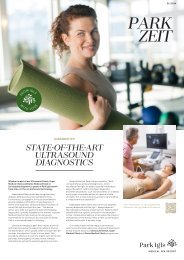Parkzeit 2021-2 (EN)
Guest magazine Park Igls
Guest magazine Park Igls
You also want an ePaper? Increase the reach of your titles
YUMPU automatically turns print PDFs into web optimized ePapers that Google loves.
PLAQUES consist of a nucleus, the amyloid<br />
nucleus, pathologically altered nerve cell processes<br />
and other cells, i.e. the supporting cells. In simplified<br />
terms, one speaks of amyloids. In many Alzheimer's<br />
patients, amyloids are found not only between nerve<br />
cells but also in the smaller blood vessels of the brain.<br />
That’s why about one in five Alzheimer's patients<br />
suffers not only from Alzheimer-type dementia, but<br />
also from vascular dementia at the same time. The<br />
small blood vessels in the brain are constricted or<br />
even blocked with amyloids, which can trigger<br />
strokes.<br />
STAGES OF ALZHEIMER'S DISEASE are<br />
differentiated in medicine into mild (early-stage<br />
Alzheimer's disease), moderate (progressive<br />
Alzheimer's dementia) and severe (advanced<br />
Alzheimer's dementia). Doctors use tests, such as<br />
the MMST (the Mini-Mental Status Test), an<br />
interview with nine task components, to determine<br />
patient’s current stage.<br />
15 %<br />
15 %<br />
5 % Alzheimer's disease<br />
65 %<br />
Vascular dementias<br />
Mixed Dementias<br />
Other<br />
DISEASE PROGRESSION<br />
In Alzheimer's disease, the short-term memory<br />
is affected first. The long-term memory is affected<br />
later. In the beginning, those affected forget<br />
situations that have just happened as if they have<br />
been erased, and some names for the most banal<br />
everyday things, such as shoes, no longer spring to<br />
mind. As the disease progresses, memories<br />
disappear, as do everyday skills such as how to<br />
handle eating utensils or personal hygiene activities.<br />
DURATION OF THE ILLNESS<br />
On average, Alzheimer's disease lasts about<br />
eight years after diagnosis, though this varies from<br />
patient to patient, especially since the disease is<br />
often detected or diagnosed late. There are patients<br />
who live with their disease for 20 years. Nevertheless,<br />
Alzheimer's generally leads to death in its final stages.<br />
The reason that the condition becomes fatal is<br />
that the immune system of those affected continues<br />
to weaken, so that infections become more<br />
frequent. For instance, patients are more likely to<br />
contract pneumonia and other infections. Since<br />
patients in the final stage are usually already of an<br />
advanced age, many also suffer from other physical<br />
diseases which can also lead to death.<br />
ALZHEIMER RISK FACTORS<br />
Even though the causes of Alzheimer's disease<br />
remain largely unclear, there are definitely some<br />
risk factors that promote the onset of Alzheimer's<br />
dementia. These include obesity, high blood<br />
pressure, high cholesterol, high blood sugar, lack of<br />
exercise and poor nutrition, as well as alcohol<br />
abuse, type 2 diabetes mellitus or permanent stress<br />
(see WHO recommendations).<br />
obesity<br />
high cholesterol<br />
lack of exercise<br />
poor nutrition<br />
type 2 diabetes mellitus<br />
high blood pressure<br />
high blood sugar<br />
alcohol abuse<br />
permanent stress<br />
WOM<strong>EN</strong> are statistically more likely to develop<br />
Alzheimer's disease. This may be because men<br />
don't live to be that old on average, and for that<br />
reason alone, their risk is simply lower. However, it<br />
is a fact that the number of new cases is higher in<br />
women than in men.<br />
VASCULAR DEM<strong>EN</strong>TIAS refer to forms of<br />
dementia caused by disturbances in the blood<br />
supply to the brain. For various reasons such as<br />
deposits, constriction or clotting, the blood vessels<br />
are no longer able to adequately fulfil their task of<br />
transporting blood. What are the consequences?<br />
Nerve cells become damaged or even die. High<br />
blood pressure is often the underlying cause,<br />
although obesity or smoking can also promote<br />
vascular dementia. Vascular dementia accounts for<br />
about 15 percent of all dementia cases and is the<br />
most common form of dementia after Alzheimer's<br />
disease. Although vascular dementia cannot be<br />
cured, there is a good chance that its cause, i.e.<br />
circulatory problems, can be treated. It is important<br />
that vascular dementia is detected and treated as<br />
early as possible.<br />
BINSWANGER'S DISEASE is amongst the<br />
most common classifications of vascular dementia<br />
cases. The cause is a thickening of the walls in small<br />
blood vessels of the brain (arteriosclerosis). This<br />
subcortical arteriosclerotic encephalopathy (SAE<br />
disease) is called Binswanger's disease after the<br />
German neurologist Otto Ludwig Binswanger.<br />
Sometimes, the terms 'subcortical dementia' or<br />
'subcortical vascular dementia' are also used. Those<br />
who have suffered from high blood pressure or<br />
other vascular diseases for many years are often<br />
affected by this condition.<br />
MULTI-INFARCT DEM<strong>EN</strong>TIA is a form of<br />
dementia in which small cerebral infarctions occur<br />
due to repeated vascular occlusions. They slowly<br />
destroy the brain in many small steps. Sometimes, a<br />
single, severe stroke is responsible, but often there<br />
are several multi-strokes.<br />
SYMPTOMS OF VASCULAR DEM<strong>EN</strong>TIA,<br />
unlike Alzheimer's, can occur quite suddenly –<br />
depending on where a blood vessel has clotted in<br />
the brain. Multi-infarct dementia, in particular,<br />
progresses almost inconspicuously over long<br />
phases. At times, the affected person is clearly<br />
impaired, for example, cannot find words or has<br />
difficulty remembering, then suddenly he or she is<br />
lucid once again. Typical symptoms include<br />
memory, speech, thinking and movement disorders,<br />
problems with orientation or mood swings.<br />
1 + 1 = ?<br />
thinking<br />
?<br />
orientation<br />
mood<br />
?<br />
memory<br />
distancing<br />
RISK FACTORS FOR VASCULAR DEM<strong>EN</strong>TIA<br />
include high blood pressure, smoking, diabetes<br />
mellitus, high LDL cholesterol levels, heart failure<br />
and cardiac arrhythmias. These risk factors all have<br />
one thing in common: They can lead to damage of<br />
the blood vessels, deposits (arteriosclerosis), poor<br />
blood circulation and strokes. If none of the risk<br />
factors apply, family history may also promote the<br />
development of vascular dementia. There is an<br />
increased risk of vascular dementia if ancestors,<br />
parents or close relatives have suffered strokes<br />
more frequently and if family members are prone to<br />
high blood pressure.<br />
high blood pressure<br />
diabetes mellitus<br />
heart failure<br />
family history<br />
smoking<br />
high LDL cholesterol levels<br />
DEM<strong>EN</strong>TIA PREV<strong>EN</strong>TION<br />
A study published in Nature in 2009 impressively<br />
illustrated that modified fasting with a thirty percent<br />
calorie reduction over a period of just three months<br />
could significantly improve memory performance<br />
in the fasting group.<br />
ADDITIONAL INFORMATION ON DEM<strong>EN</strong>TIA<br />
Dementia is an enormous burden for those<br />
affected and for their relatives. You can find more<br />
information on this topic here:<br />
A Austrian Alzheimer Society<br />
D German Alzheimer’s Society<br />
UK Alzheimer's Society<br />
Sources:<br />
Alzheimer Forschung Initiative e.V., www.pflege.de<br />
18<br />
SPECIAL TOPIC: DEM<strong>EN</strong>TIA<br />
SPECIAL TOPIC: DEM<strong>EN</strong>TIA 19
















